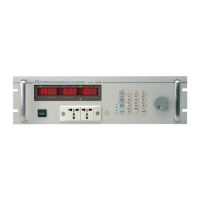Theories of Operation
4.3 AC/DC Power Stage Converter
The switch -mode PWM converter is composed of a power factor controller and a boost circuit
on I board. To avoid the switching losses, the user has to turn on the converter at zero voltage.
The auxiliary DC voltages identified as 15V, −15V, 12V, 5V, and −24V are generated on the M1
board.
4.4 DC/DC Power Stage Converter
This assembly is identified as G board. It generates two isolated power outputs for the DC input
voltage on H board. These two outputs of DC voltage and the input DC voltage are isolated
from each other by the high frequency transformers.
4.5 DC/AC Inverter
This inverter includes C board, H board and O board. The advanced PWM technology is
applied to this system in order to obtain more stability.
C board is the PWM controller. The maximum peak current is clamped to protect power
MOSFET.
H board is made up of the full bridge of MOSFET power components. The PWM control signal
from C board is applied to the full bridge to amplify the sine wave at the end of output. The low
pass filter can reject the switching frequency component.
O board consists of the range relays and output relays. The range relays connect two sets of the
secondary of output transformers together in parallel or series.
4.6 CPU
The CPU, A board, controls the circuit through 80C188 CPU. A microprocessor circuit receives
commands from the GPIB, the RS-232C controller, or the keyboard on the front panel. It sends
the digital signal to set the output parameters of the power source, and establishes the output
sinusoidal waveform table. Data from the measurement circuits are received and reported to the
seven-segment display and GPIB. The data of set parameters and one-key operation are stored
in EEPROM.
4-3

